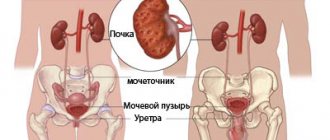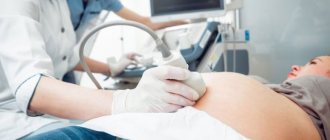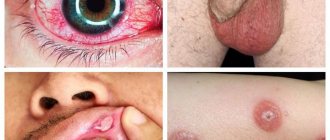Pain and other unpleasant symptoms that often accompany sexually transmitted infections of the genitourinary system are far from the only problem. The main danger of STDs is serious complications. Here are some of them: cystitis, urethritis, inflammation of the endometrium of the uterus in women, orchitis in men, various neoplasms of the genital organs. If the infection does not manifest symptoms that are obvious to the patient, which is typical for pathogens such as Ureaplasma spp, you can unintentionally infect your partner. When determining the causes of infertility in couples, it is often discovered that there are inflammatory processes or low sperm quality (small number of motile sperm). Sometimes bacteria can only be detected during an examination. The ability to get pregnant is mainly influenced not by the very fact of the presence of ureaplasma in the body, but by the current inflammatory process. Both partners should receive treatment, especially if there are signs of inflammation.
- Basic information
- What is ureaplasmosis
- Risk factors
- Mechanism of action
- Symptoms in men
- Consequences and complications
- Diagnostics
- Treatment
Mycoplasma hominis and Ureaplasma spp. – microorganisms that are classified as opportunistic. They can cause pelvic inflammatory disease (PID), as well as complications during pregnancy, during and after childbirth. These simple microorganisms received the name “ureaplasma” due to their ability to produce an enzyme that breaks down urea. Among ureaplasma (Ureaplasma spp) there are two types - Ureaplasma urealyticum and Ureaplasma parvum. In 2006, WHO experts identified U.urealyticum as a potential causative agent of urethritis in men, and possibly PID in women.
Basic information:
Ureaplasma is a genus of bacteria that occupies an intermediate position between viruses and single-celled microorganisms. This is an opportunistic microflora that can cause inflammation of the mucous membranes of the human genital organs and urinary tractii.
Opportunistic infection:
- found in most healthy people. The prevalence of microorganisms is evidenced by the following indicators: these bacteria are detected in most people (up to 80%), while the pathological course is usually no more than ten percent)iii
- Children's age of carriers does not exclude the possibility of detection of Ureaplasma
- may not be present in everyone from among those with whom the carrier entered into intimate relationships
- there are difficulties in complete elimination from the body; after several courses of antibacterial therapy, microbes may be detected again.
Microorganisms of this genus were discovered as a result of scientists' study of the microflora of the urogenital tract in the sixties of the last century. It has been suggested that the presence of Ureaplasma is one of the possible causes of the development of inflammatory diseases in this area. Then interest in the discovery decreased due to diagnostic difficulties (the small size of the bacterium and the inability to grow in a nutrient medium) and reappeared with the advent of the PCR (polymer chain reaction) method. The indication for treatment is the presence of clinical and laboratory signs of the inflammatory process. Previously, when identifying Ureaplasma spp. in the amount of 10 to the fourth degree CFU (colony forming units) and more, monotherapy with antibiotics was prescribed, but today this standard has changed: in some cases immunomodulators are added, especially if one course of antibiotics was not enoughiv.
Ureaplasma - more about the microorganism
Ureaplasma is a bacterium that belongs to the category of opportunistic microorganisms.
It is related to mycoplasmas, but unlike the latter it can break down urea into ammonia. Ureaplasmas from the genitourinary system are small in size and can penetrate through pores of 0.22 microns. In addition to U. Urealyticum, which provoke inflammation of the genitourinary organs, there are U. Parvum, which usually live on the mucous membranes of clinically healthy women. These are two biotypes that are divided into serotypes:
- Parvum – 4 serotypes (1, 3, 6, 14);
- Urealyticum – 10 serotypes (remaining numbers).
Currently, research is being conducted into the serotypes responsible for causing inflammation in women and men. In one person, the test results may simultaneously contain different serotypes of ureaplasma.
Get tested for ureaplasmosis
What is Ureaplasmosis in men
This inflammatory disease is a predominantly sexually transmitted infection with often no symptoms. Mainly accompanied by urination disorders, sexual dysfunction, and infertility. Diagnosed by laboratory analysis of scrapings from the urethra. Treatment includes antibacterial and symptomatic drugs, as well as immunocorrectors and immunomodulators. It is believed that ureaplasmosis increases the likelihood of contracting HIV.
Risk factors
The causative agent of this disease is the bacterium Ureaplasma of two varieties U. Parvum and U. Urealyticum. The spread of infection is most often patients with a latent form of pathology, in which the patient does not feel symptoms. Transmission from man to woman occurs during intimate contact. The main risk factors for becoming infected and infecting a partner include: young age and early onset of sexual activity, promiscuity, ignoring barrier contraception, the presence of chronic inflammatory processes of the genitourinary system, as well as weakened immunity, deficiency or excess of vitamins and metabolic disorders.
Mechanism of action in the body
Once in the body, the bacterium attaches to the cells of the mucous membrane using specific proteins. Colonization by microorganisms increases if the local immunity of a person is reduced. Under the action of an enzyme produced by bacteria, immunoglobulin (a protein with protective properties) is broken down 1.
The ability of microorganisms to form biofilms determines their virulence and resistance to treatment with antibacterial agents. This property increases the susceptibility to the chronic presence of infection in the body.
Therapy
Effective treatment of ureaplasma urealyticum requires an integrated approach. The treatment regimen is selected individually, depending on the type of pathogen, the patient’s medical history and concomitant diseases. The most commonly prescribed drugs are:
- antibiotics;
- immunomodulators;
- antiprotozoal drugs;
- fungicidal agents;
- vitamins.
Treatments include physiotherapy and local treatment. Correct selection of antibiotic is the most important stage of therapy. If the patient has previously been treated for this disease, it is important to notify the doctor and clarify which drug was taken. Ureaplasma is a bacterium that lacks a cell wall, so it very quickly adapts to the antibiotic and becomes insensitive to it.
On average, the course of treatment is about 2 weeks. Since the disease is sexually transmitted, therapy is also prescribed to the sexual partner. After completing the course, you must be tested for ureaplasma urealiticum to evaluate the effectiveness of treatment.
If successful, the specialist may prescribe a number of restorative medications and procedures. The most popular are the following:
- prostate massage;
- drugs to restore intestinal flora;
- hepatoprotectors;
- immunomodulators;
- special gentle diet.
Ureaplasma in men: symptoms and treatment
In men, the following manifestations of the disease are observed:
- mucous or purulent discharge from the urethra
- itching and burning when urinating
- discomfort and pain during intercourse
- frequent urge to urinate
- pain in the perineum
- swelling and redness of the external urethral opening
These and other symptoms are an indication for examination for STDs, including Ureaplasma spp. Sperm donors, patients diagnosed with infertility, and women trying to become pregnant and having a history of termination of pregnancy for medical reasons are subject to laboratory examination.
It may take twenty-one days or more from the time of infection until any symptoms appear. It is difficult to accurately determine the time of infection, since the disease is often asymptomatic. When the disease manifests itself, a burning sensation, discomfort and pain when urinating, and acute pain during sexual intercourse are felt. The body temperature rises to 38 ° C, the patient experiences weakness, chills, frequent urge to urinate, especially at night, ejaculates quickly, and at the same time libido decreases. The discharge is small, transparent and can stop on its own. In the future, pain symptoms may increase, and the patient may experience acute pain in the perineum.
Make an appointment
Ureaplasma quickly adapts to drugs and becomes resistant. Independent selection of a treatment regimen, as well as cessation of treatment before completion of the course, leads to a complication of the situation. When symptoms appear, as well as every six months even in their absence, if you are sexually active, you must undergo examinations. A specialist, based on the research conducted and the collected anamnesis/information about past treatments, based on experience, statistics and the latest information from the scientific community, will be able to select the right antibiotics and supportive medications.
At the bottom of the page you will find photographs, biographies and information about our urologists. You can make an appointment with a specific specialist through the form on the website or by calling the contact center and make an appointment at a clinic convenient for you with the nearest available doctor.
Consequences and complications of ureaplasmosis in men
Male ailments that develop as a result of the implementation of pathological properties of bacteria entering the genitourinary system include inflammation of the glans penis and foreskin, inflammation of the epididymis and the testicle itself (orchitis), prostatitis, and urinary retention. Impotence often occurs, including for psychogenic reasons due to discomfort and pain during sexual intercourse, and libido decreases. Patients are at risk for developing autoimmune rheumatic diseases. Ureaplasmosis was first associated with possible causes of infertility in men in 1967. In the seminal fluid of infertile men, this pathogen is isolated in more than 58% of cases, while in fertile men this figure does not exceed 30% 3. Ureaplasma attaches to sperm, thereby interfering with their maturation; the presence of microorganisms reduces the activity of male germ cells and destroys their. With a long course of the disease, the production of prostate secretion, which ensures the motility and viability of sperm, decreases.
Routes of infection
Adults become infected with ureplasmosis only through sexual contact, and the incubation period lasts from 7 to 20 days. In an organism with a strong immune system, the disease can lie dormant for years. Factors contributing to the activation of the virus are:
- general decrease in the protective function of the body;
- exacerbation of chronic diseases;
- presence of other infections;
- injury to the genitourinary organs;
- stress and nervous overload;
- changes in hormonal levels due to pregnancy, abortion or other circumstances.
Diagnosis of ureaplasmosis
Diagnosis and treatment in men is carried out by urologists and sometimes by venereologists. To effectively treat a patient, it is important to identify his sexual contacts. Partners need to undergo testing, especially in the case of unprotected sexual intercourse. As a rule, after an examination, the doctor refers you for analysis. Most often, ureaplasma is detected using PCR (urine and scrapings from the urethra are examined)2. During exacerbations of chronic untreated or acute ureaplasmosis, a general clinical blood test has a number of features: an increased value of leukocytes, accelerated ESR and changes in biochemical parameters. When examining a smear from the urethra and urine, a high level of white blood cells is also detected. To exclude infection affecting other organs and systems, it is recommended to do an ultrasound examination of the kidneys, prostate, bladder, and scrotum.
How to diagnose the disease
Two tests help identify ureaplasma urealiticum in men: PCR and bacterial culture. In the first case, ureaplasma is indicated by the presence of DNA of this organism in the smear. Cultivation of bacteria makes it possible to identify them in the environment and establish the sensitivity of the strain to certain groups of drugs. In addition, the doctor may order the following tests:
- ELISA;
- spermogram;
- microbiological examination of sperm.
Based on your medical history, tests for other pathogens may be prescribed.
Prevention
It is easier to prevent any disease than to treat it, especially one that is mildly symptomatic. Prevention measures include:
- maintaining intimate hygiene;
- avoidance of casual sexual intercourse;
- the use of contraception during sexual intercourse, especially during oral or anal contact of the genitals, since the mucous membranes of the throat and intestines are extremely susceptible to bacteria;
- be periodically examined for the presence of ureaplasma.
Treatment of ureaplasmosis in women requires a more careful approach due to the fact that her health guarantees the health of future generations. In case of casual sexual intercourse, emergency measures can be taken to prevent infection with ureaplasmosis - the introduction of local antiseptics into the urethra. This method is rational to use only in the first couple of hours after sexual intercourse. In addition, abuse of this method leads to inevitable burns of the mucous membrane of the urethral canal.
Rules for the use of antibiotics for ureaplasma
The timing and effectiveness of treatment regimens largely depends on how carefully the patient follows the recommendations for taking basic medications.
In the case of ureaplasmosis, the main group of drugs are antibiotics.
In themselves, they are regarded as medications that require especially careful use by doctors and patients.
It is necessary to reduce the number of side effects, getting the maximum benefit from the use of drugs in this series.
It is recommended to follow these simple rules:
- completely abandon any attempts at self-prescription, relying only on the recommendations received from the doctor
- do not listen to friends and acquaintances regarding taking antibiotics, relying only on the opinion of a physician
- ideally, start taking the medicine only after it has been proven by evaluating the results of sensitivity culture that the microorganism will respond to the chosen treatment (unfortunately, this is not always possible and depends on the hospital’s equipment)
- carefully follow the doctor-recommended dosage of medications, in no case arbitrarily reducing them or increasing them to achieve a faster effect
- Do not under any circumstances cancel treatment before the time prescribed by the doctor, even if it seems that the disease has been completely defeated and left behind.
If the regimen recommended by the doctor is carefully followed throughout the entire treatment period, the likelihood of success is much higher.
Than when a patient voluntarily prescribes and discontinues medications for himself.
The main thing is to notice the first signs of ureaplasma in men and begin the most complete treatment possible under the supervision of a knowledgeable medical professional.
Control tests after treatment will be a mandatory part of the end of therapy.
Without their results, it is impossible to talk about the onset of recovery, which the doctor will warn the patient about.
Treatment
How to treat ureaplasmosis? Most specialists adhere to a comprehensive methodology, which includes the following stages:
- antibacterial drugs for ureaplasmosis can be selected as a complex of drugs - tablet forms are combined with douching or vaginal suppositories;
- immunomodulators or dental agents - to preserve the composition of the microflora of the vagina and gastrointestinal tract;
- temporary abstinence from sexual intercourse;
- diet therapy - exclusion from the diet of fried, spicy, salty and alcoholic foods.
When treating ureaplasmosis, it is necessary to involve the patient and his sexual partners in the process. At the same time, it is necessary to treat all identified infectious and viral diseases. After completing complex therapy, it is necessary to monitor the presence of ureaplasma bacteria and its condition for the first three to four months.
Therapy is divided into acute and chronic. With acute ureaplasma, the muscles may be toned. The main treatment for the acute stage of the disease is based on taking antibiotics, sensitivity to which is detected in the laboratory.
Chronic or complicated forms involve long-term use of antibiotics, and one group of drugs can replace another. In this case, it is necessary to take dental medications and immunomodulators to maintain the protective function of the body and the favorable composition of the microflora. As part of chronic therapy, they often resort to physiotherapy - hirudotherapy, electrophoresis and magnetic fields, microwaves, mud therapy, prostate massage or gynecological massage, as well as other methods.
Folk recipes
Among the decoctions and infusions from folk recipes for the treatment of ureaplasmosis, preparations that increase the body's protective functions or strengthen the immune system are suitable. This also includes eating dishes with foods rich in phytoncides, as a means of combating the growth of viral bacteria.
The most popular folk advice are:
- eating garlic;
- decoction or cold infusion of goldenrod;
- infusions from a mixture of herbs using licorice root, chamomile flowers or string, nettle leaves and other herbs.
Ureaplasma: causes of chronicity
Due to the peculiarities of its structure, ureaplasma is insensitive to standard antibacterial therapy.
Often, long-term targeted treatment does not lead to complete sanitization of the body from the pathogen.
At the same time, the chronic course of the disease begins.
It is characterized by the absence of unpleasant symptoms for a longer period of time.
When immunity decreases, the disease worsens.
Then the symptoms go away again with treatment.
This does not mean recovery.
It is quite difficult to achieve a complete cure when ureaplasmosis is chronic.
This often requires a long course of medications and constant laboratory monitoring.
Treatment is also complicated by the fact that today people often take antibiotics uncontrollably and without a doctor’s testimony.
This creates drug resistance in microorganisms.
For optimal therapy, a special analysis should be performed: bacteriological culture with a sample of antibiotics.
In such a study, small plates soaked with an antibiotic are placed on the culture of the microorganism.
Next, we monitor which drug caused the most dramatic reduction in the growth of ureaplasma.
The results of the analysis give the doctor the opportunity to prescribe the drug to which the bacterium is most sensitive.
Important! You should not self-medicate if you suspect ureaplasmosis or another infection.
Self-administration of antibacterial agents forms colonies of resistant bacteria inside the body.
Coping with this disease is quite difficult and expensive.
The doctor is forced to prescribe rarer and more expensive drugs.
At the slightest suspicion of infection, consult a specialist.
Complications
Among the complications, it is also customary to distinguish female and male ones, however, both groups have a common sign of serious damage to the organs of the genitourinary system. The disease can lead to cystitis, pyelonephritis, disturbances in the enzymatic system, due to which muscle pain is observed with ureaplasmosis, arthritis may develop, or joints may be affected.
Main complications in men:
- urethritis - discomfort during urination, as well as pain and stinging, burning in the urethra;
- epididymitis - inflammation affects the epididymis;
- prostatitis – leads to problems with erection;
- infertility - due to disturbances in the structure of sperm.
Main complications in women:
- inflammation of the mucous membranes of the uterus and vagina - colpitis, endometritis and others;
- inflammation of the muscles on the uterus - myometritis;
- cervical erosion;
- the occurrence of adhesions;
- miscarriage, miscarriage, premature birth.
Ureaplasma: causes of asymptomatic course
The reasons for the asymptomatic course lie in the body's defenses.
High immunity, good quality of life, proper nutrition - all this prevents ureaplasma from causing symptoms.
Doctors often come to the conclusion that ureaplasma is more likely an opportunistic organism.
There is no consensus here.
Sometimes the harm that large doses of antibiotics cause to the body can be greater than the harm from ureaplasmosis without exacerbations.
To treat or not to treat?
Often this question arises in the absence of signs of inflammation.
It should be understood that each situation can be individual.
The doctor makes the final decision after a complete examination.
The clinical picture, quantitative indicators and other parameters are taken into account.
It is definitely worth treating ureaplasma before planning a pregnancy for both partners.
This is due to the fact that the inevitable decrease in the pregnant woman’s immunity will contribute to inflammation.
It is worth undergoing a course of treatment even if you are diagnosed with infertility.










